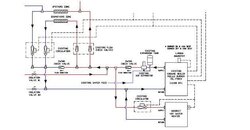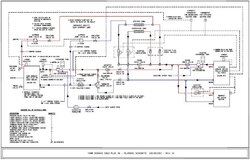HELLO EVERYONE,
FINALLY THOUGHT I HAD THE SOLO 40 PLUS WORKING THE WAY I WANTED HOWEVER QUESTIONED THE RATE THAT THE HOUSE WAS HEATING UP USING THE WOOD BOILER VERSUS THE OIL FIRED BOILER. TO TEST MY CONCERN, I TOOK A MEASUREMENT AT THE POINT LABELED 'MEASUREMENT POINT' IN THE ATTACHED DIAGRAM BASED UPON THE FOLLOWING TWO SETS OF CONDITIONS:
(1) WITH WOOD BOILER COLD (HAD NOT BEEN RUN FOR MORE THAN 4 DAYS) AND THE SUPPLY AND RETURN TO THE WOOD BOILER ISOLATED (VALVES CLOSED ALTHOUGH NOT SHOWN IN THE ATTACHED DIAGRAM), THE OIL BOILER FIRED TO SETPOINT AND THE TEMPERATURE READING ON THE IR THERMOMETER READS APPROXIMATELY 180 DEGF (AT MEASUREMENT POINT) AND THE BOILER GAUGE READS APPROXIMATELY THE SAME (180-185 DEGF).
(2) WITH THE WOOD BOILER VALVED IN (ISOLATION VALVES OPEN) AND AT SETPOINT (188 DEGF), ACCORDING TO THE CONTROL PANEL GAUGE, AND DRAFT FAN OFF, THE IR THERMOMETER READS APPROXIMATELY 145-160 DEGF (AT MEASUREMENT POINT). AT THIS CONDITION AND SINCE I HAD JUST FIRED THE WOOD BOILER, THE OIL BOILER WAS STILL HOT AND STILL MEASURED APPROXIMATELY 180-185 DEGF ON THE BOILER GAUGE)
WHEN I FIRST SUSPECTED THE LOWER TX AT THE COMMON SUPPLY HEADER WITH WOOD BOILER OPERATING I SUSPECTED THAT THE SWING CHECK VALVE ON THE SUPPLY SIDE OF THE OIL BOILER WAS NOT SWINGING COMPLETELY CLOSED WITH WOOD BOILER CIRCULATOR IN OPERATION AND THAT COOL WATER FROM THE OIL BOILER WAS BEING 'STRIPPED' INTO THE HOT WATER SUPPLY STREAM WHEN OPERATING AT TX WITH THE WOOD BOILER. THE OBSERVATIONS AS DESCRIBED ABOVE WOULD TEND TO CONTRADICT THIS THEORY AS THE OIL BOILER WAS STILL AT OPERATING TX FROM THE PRIOR OPERATION.
OK, MY NEXT THEORY WAS THAT MAYBE THE GAUGE ON THE CONTROL PANEL OF THE WOOD FIRED BOILER WAS NOT ACCURATE (I.E. ACTUAL TX ONLY 160 DEGF WHEN GAUGE READING 180-185 DEGF). TO TEST THIS, WITH THE WOOD BOILER AT TX SETPOINT OF 185 DEGF, I DIALED THE OVERTEMP AQUASTATE BACK BELOW 150 DEGF THEN SLOWLY ADJUSTED THE SETTING UNTIL THE CONTACT CLOSED ON RISING TEMP AND ON THE AQUASTAT THIS OCCURED AT APPROXIMATELY 187 DEGF. THEREFORE, I HAVE TO ASSUME THE GAUGE ON THE BOILER IS CORRECT.
AT THIS POINT I SUSPECT THIS HAS SOMETHING TO DO WITH THE TERMOVAR MIXING VALVE. I AM ALMOST 100% SURE I HAVE THIS PLUMBED CORRECTLY. AS A MATTER OF FACT, WHEN I RECEIVED THE TERMOVAR FROM BIOMASS USA SOMEONE HAD EVEN GONE TO THE TROUBLE OF MARKING THE PORTS WITH A BLACK MARKER THAT I BELIEVE I HAD VERIFIED AGAINST THE VALVE OEM LABELING. IN ADDITION, THE BALANCING VALVE ON THE PORT 1 SIDE IS SET AT 45 DEGREES AS RECOMMENDED BY TARM ALTHOUGH THERE IS NO CLEAR REASONING WHY IT SHOULD BE SET AT THIS POSITION. THE WAY THE MANUAL EXPLAINS THE OPERATION OF THIS MIXING VALVE IS THAT AT 160 DEGF (72 DEGC) AND RISING, PORT 2 OF THE TERMOVAR BEGINS TO OPEN AND PORT 1 BEGINS TO CLOSE WITH PORT 2 REACHING THE FULL OPEN POSITION WHEN THE TX IS AT 172 DEGF. MANUAL DOES NOT STATE IF PORT 1 COMPLETELY CLOSES OR NOT BUT I ASSUME IT IS NEAR CLOSED POSITION. PORT 3 IS ALWAYS OPEN. ONE HYPOTHESES I HAVE IS THAT EITHER PORT ONE IS NOT CLOSING AT ALL OR THAT PORT 2 (FROM RETURN HEADER) IS LEAKING BACK INTO PORT 1 AND THE HOT WATER SUPPLY FROM THE MIXING VALVE IS BEING TEMPERED INCORRECTLY. HAVE CONSIDERED CLOSING THE BALANCING VALVE COMPLETELY AT OPERATING TEMP (AT WHICH POINT I BELIEVE RISK OF SHOCKING BOILER WITH RETURN WATER BELOW 140 DEGF IS MINIMAL) TO ESSENTIALLY ISOLATE THE MIXING PORTS UNLESS INTERNALLY THEY ARE SCREWED UP.
I AM USING A GRUNDFOS 3-SPEED CIRCULATOR ON MEDIUM SPEED AND MY ACTUAL NUMBER OF HEATING ZONES IS TWO UNLIKE THE DIAGRAM THAT SHOWS THREE. I AM NOT USING THE TERMOVAR LOADING UNIT WITH BUILT-IN CICRULATOR AND BALANCING VALVE.
DOES ANYONE HERE IN THE FORUM HAVE ANY SUGGESTIONS AND/OR INSIGHT INTO ABOVE OBSERVATIONS. ANY HELP WOULD BE MUCH APPRECIATED. YOUR INPUT HELPED SOLVE MY 'KETTLING' PROBLEM AND I'M HOPING THAT YOUR INSIGHTS WILL HELP ME GET BEYOND THIS ISSUE AND GET THIS THING WORKING IN AN OPTIMUM MANNER BEFORE THE REAL COLD SETS IN HERE IN THE NORTHEAST.
THANKS,
KEN
FINALLY THOUGHT I HAD THE SOLO 40 PLUS WORKING THE WAY I WANTED HOWEVER QUESTIONED THE RATE THAT THE HOUSE WAS HEATING UP USING THE WOOD BOILER VERSUS THE OIL FIRED BOILER. TO TEST MY CONCERN, I TOOK A MEASUREMENT AT THE POINT LABELED 'MEASUREMENT POINT' IN THE ATTACHED DIAGRAM BASED UPON THE FOLLOWING TWO SETS OF CONDITIONS:
(1) WITH WOOD BOILER COLD (HAD NOT BEEN RUN FOR MORE THAN 4 DAYS) AND THE SUPPLY AND RETURN TO THE WOOD BOILER ISOLATED (VALVES CLOSED ALTHOUGH NOT SHOWN IN THE ATTACHED DIAGRAM), THE OIL BOILER FIRED TO SETPOINT AND THE TEMPERATURE READING ON THE IR THERMOMETER READS APPROXIMATELY 180 DEGF (AT MEASUREMENT POINT) AND THE BOILER GAUGE READS APPROXIMATELY THE SAME (180-185 DEGF).
(2) WITH THE WOOD BOILER VALVED IN (ISOLATION VALVES OPEN) AND AT SETPOINT (188 DEGF), ACCORDING TO THE CONTROL PANEL GAUGE, AND DRAFT FAN OFF, THE IR THERMOMETER READS APPROXIMATELY 145-160 DEGF (AT MEASUREMENT POINT). AT THIS CONDITION AND SINCE I HAD JUST FIRED THE WOOD BOILER, THE OIL BOILER WAS STILL HOT AND STILL MEASURED APPROXIMATELY 180-185 DEGF ON THE BOILER GAUGE)
WHEN I FIRST SUSPECTED THE LOWER TX AT THE COMMON SUPPLY HEADER WITH WOOD BOILER OPERATING I SUSPECTED THAT THE SWING CHECK VALVE ON THE SUPPLY SIDE OF THE OIL BOILER WAS NOT SWINGING COMPLETELY CLOSED WITH WOOD BOILER CIRCULATOR IN OPERATION AND THAT COOL WATER FROM THE OIL BOILER WAS BEING 'STRIPPED' INTO THE HOT WATER SUPPLY STREAM WHEN OPERATING AT TX WITH THE WOOD BOILER. THE OBSERVATIONS AS DESCRIBED ABOVE WOULD TEND TO CONTRADICT THIS THEORY AS THE OIL BOILER WAS STILL AT OPERATING TX FROM THE PRIOR OPERATION.
OK, MY NEXT THEORY WAS THAT MAYBE THE GAUGE ON THE CONTROL PANEL OF THE WOOD FIRED BOILER WAS NOT ACCURATE (I.E. ACTUAL TX ONLY 160 DEGF WHEN GAUGE READING 180-185 DEGF). TO TEST THIS, WITH THE WOOD BOILER AT TX SETPOINT OF 185 DEGF, I DIALED THE OVERTEMP AQUASTATE BACK BELOW 150 DEGF THEN SLOWLY ADJUSTED THE SETTING UNTIL THE CONTACT CLOSED ON RISING TEMP AND ON THE AQUASTAT THIS OCCURED AT APPROXIMATELY 187 DEGF. THEREFORE, I HAVE TO ASSUME THE GAUGE ON THE BOILER IS CORRECT.
AT THIS POINT I SUSPECT THIS HAS SOMETHING TO DO WITH THE TERMOVAR MIXING VALVE. I AM ALMOST 100% SURE I HAVE THIS PLUMBED CORRECTLY. AS A MATTER OF FACT, WHEN I RECEIVED THE TERMOVAR FROM BIOMASS USA SOMEONE HAD EVEN GONE TO THE TROUBLE OF MARKING THE PORTS WITH A BLACK MARKER THAT I BELIEVE I HAD VERIFIED AGAINST THE VALVE OEM LABELING. IN ADDITION, THE BALANCING VALVE ON THE PORT 1 SIDE IS SET AT 45 DEGREES AS RECOMMENDED BY TARM ALTHOUGH THERE IS NO CLEAR REASONING WHY IT SHOULD BE SET AT THIS POSITION. THE WAY THE MANUAL EXPLAINS THE OPERATION OF THIS MIXING VALVE IS THAT AT 160 DEGF (72 DEGC) AND RISING, PORT 2 OF THE TERMOVAR BEGINS TO OPEN AND PORT 1 BEGINS TO CLOSE WITH PORT 2 REACHING THE FULL OPEN POSITION WHEN THE TX IS AT 172 DEGF. MANUAL DOES NOT STATE IF PORT 1 COMPLETELY CLOSES OR NOT BUT I ASSUME IT IS NEAR CLOSED POSITION. PORT 3 IS ALWAYS OPEN. ONE HYPOTHESES I HAVE IS THAT EITHER PORT ONE IS NOT CLOSING AT ALL OR THAT PORT 2 (FROM RETURN HEADER) IS LEAKING BACK INTO PORT 1 AND THE HOT WATER SUPPLY FROM THE MIXING VALVE IS BEING TEMPERED INCORRECTLY. HAVE CONSIDERED CLOSING THE BALANCING VALVE COMPLETELY AT OPERATING TEMP (AT WHICH POINT I BELIEVE RISK OF SHOCKING BOILER WITH RETURN WATER BELOW 140 DEGF IS MINIMAL) TO ESSENTIALLY ISOLATE THE MIXING PORTS UNLESS INTERNALLY THEY ARE SCREWED UP.
I AM USING A GRUNDFOS 3-SPEED CIRCULATOR ON MEDIUM SPEED AND MY ACTUAL NUMBER OF HEATING ZONES IS TWO UNLIKE THE DIAGRAM THAT SHOWS THREE. I AM NOT USING THE TERMOVAR LOADING UNIT WITH BUILT-IN CICRULATOR AND BALANCING VALVE.
DOES ANYONE HERE IN THE FORUM HAVE ANY SUGGESTIONS AND/OR INSIGHT INTO ABOVE OBSERVATIONS. ANY HELP WOULD BE MUCH APPRECIATED. YOUR INPUT HELPED SOLVE MY 'KETTLING' PROBLEM AND I'M HOPING THAT YOUR INSIGHTS WILL HELP ME GET BEYOND THIS ISSUE AND GET THIS THING WORKING IN AN OPTIMUM MANNER BEFORE THE REAL COLD SETS IN HERE IN THE NORTHEAST.
THANKS,
KEN





 ???.
???.